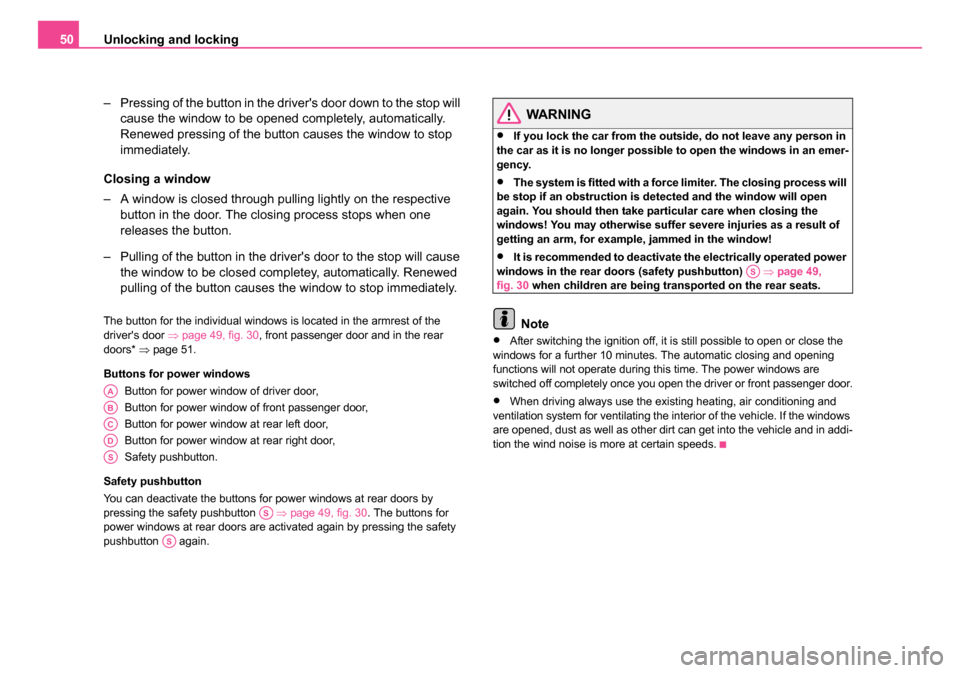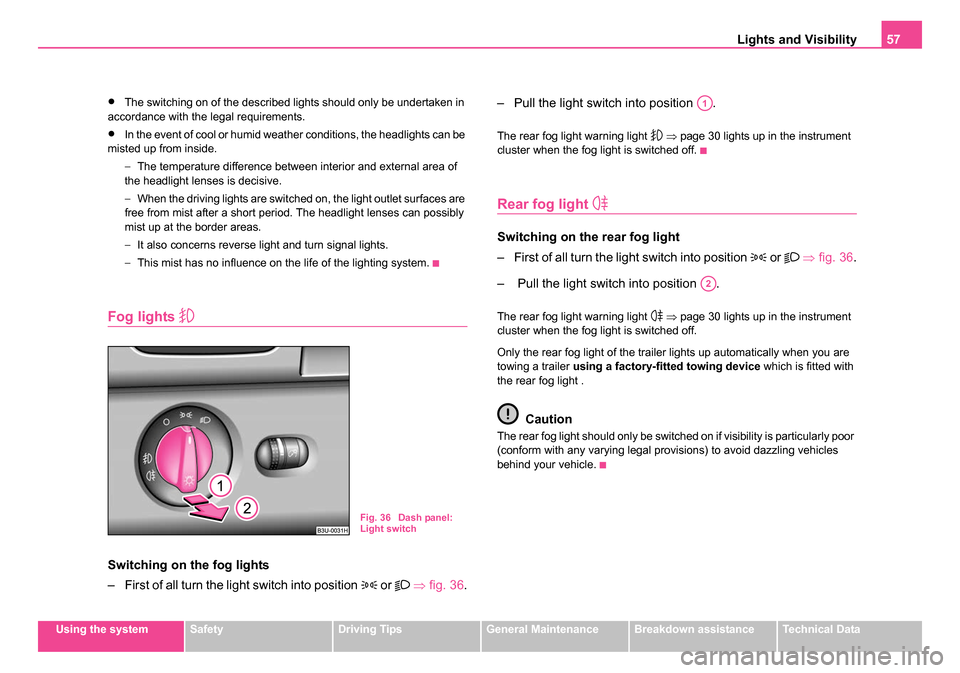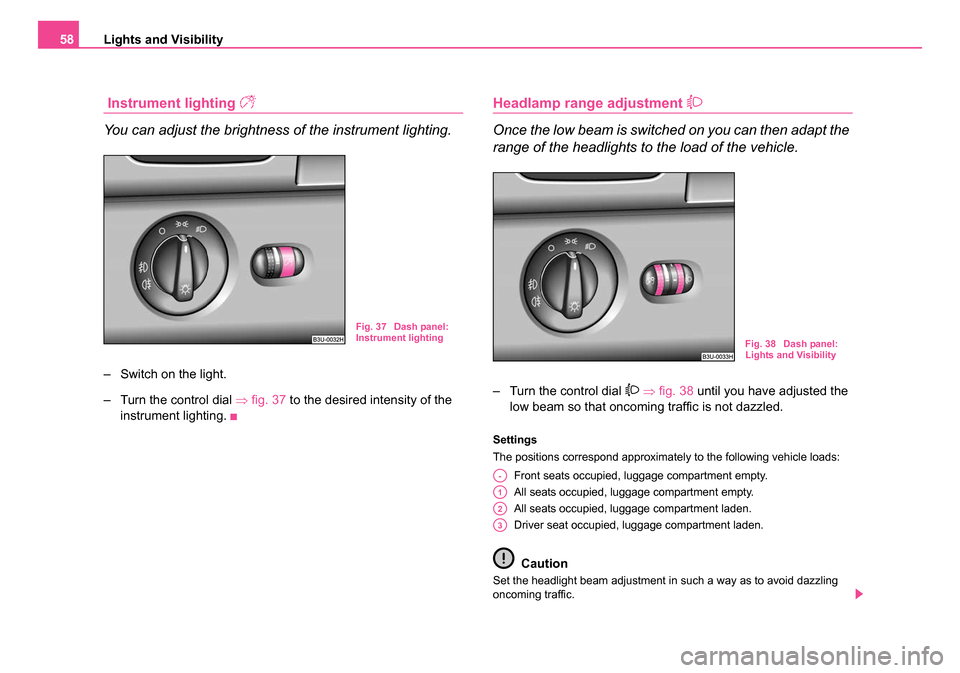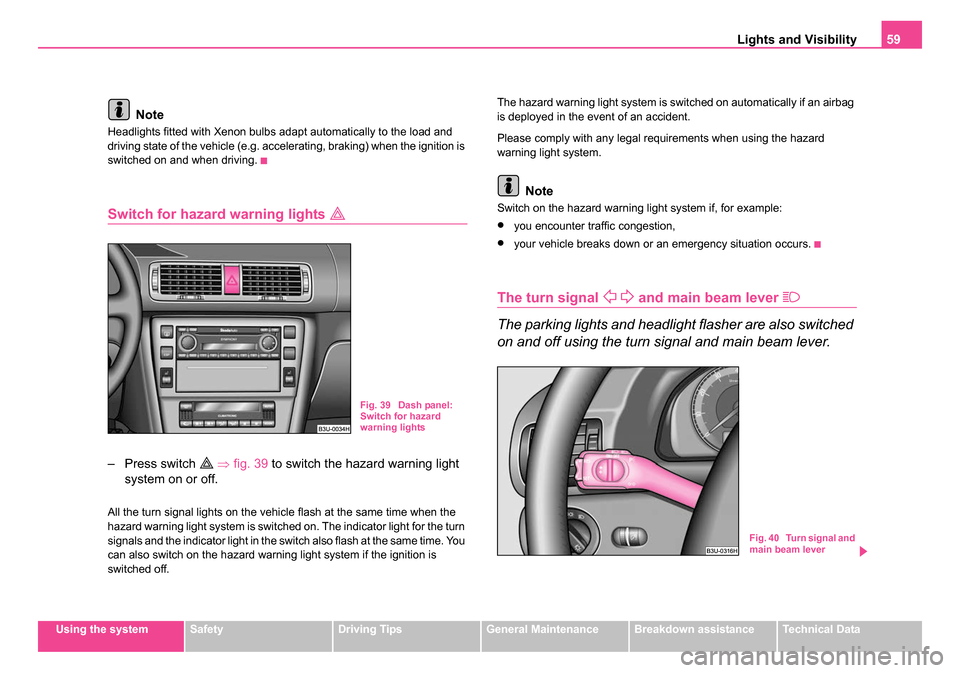SKODA SUPERB 2006 1.G / (B5/3U) Workshop Manual
Manufacturer: SKODA, Model Year: 2006, Model line: SUPERB, Model: SKODA SUPERB 2006 1.G / (B5/3U)Pages: 281, PDF Size: 12.67 MB
Page 51 of 281

Unlocking and locking
50
– Pressing of the button in the driver's door down to the stop will cause the window to be opened completely, automatically.
Renewed pressing of the button causes the window to stop
immediately.
Closing a window
– A window is closed through pulling lightly on the respective button in the door. The closing process stops when one
releases the button.
– Pulling of the button in the driver's door to the stop will cause the window to be closed completey, automatically. Renewed
pulling of the button causes the window to stop immediately.
The button for the individual windows is located in the armrest of the
driver's door ⇒page 49, fig. 30 , front passenger door and in the rear
doors* ⇒page 51.
Buttons for power windows Button for power window of driver door,
Button for power window of front passenger door,
Button for power window at rear left door,
Button for power window at rear right door,
Safety pushbutton.
Safety pushbutton
You can deactivate the buttons for power windows at rear doors by
pressing the safety pushbutton ⇒page 49, fig. 30 . The buttons for
power windows at rear doors are activated again by pressing the safety
pushbutton again.
WARNING
•If you lock the car from the outside, do not leave any person in
the car as it is no longer possible to open the windows in an emer-
gency.
•The system is fitted with a force limiter. The closing process will
be stop if an obstruction is detected and the window will open
again. You should then take particular care when closing the
windows! You may otherwise suffer severe injuries as a result of
getting an arm, for example, jammed in the window!
•It is recommended to deactivate the electrically operated power
windows in the rear doors (safety pushbutton) ⇒page 49,
fig. 30 when children are being transported on the rear seats.
Note
•After switching the ignition off, it is still possible to open or close the
windows for a further 10 minutes. The automatic closing and opening
functions will not operate during this time. The power windows are
switched off completely once you open the driver or front passenger door.
•When driving always use the existing heating, air conditioning and
ventilation system for ventilating the interior of the vehicle. If the windows
are opened, dust as well as other dirt can get into the vehicle and in addi-
tion the wind noise is more at certain speeds.AA
AB
AC
AD
AS
AS
AS
AS
NKO B5 20.book Page 50 Monday, July 3, 2006 2:09 PM
Page 52 of 281

Unlocking and locking51
Using the systemSafetyDriving TipsGeneral MaintenanceBreakdown assistanceTechnical Data
Button in front passenger door and in rear doors
A button for the relevant window is provided in these doors.
Opening a window
– Press the appropriate button down and hold it until the
window has moved into the desired position.
Closing a window
– Press the appropriate button up and hold it until the window
has moved into the desired position.
WARNING
The system is fitted with a force limiter. The closing process will be
stop if an obstruction is detected and the window will open again.
You should then take particular care when closing the windows!
You may otherwise suffer severe injuries as a result of getting an
arm, for example, jammed in the window!
Note
After switching the ignition off, it is still possible to open or close the
windows for a further 10 minutes. The automatic closing and opening
functions will not operate during this time. The power windows are
switched off completely once you open the driver or front passenger
door.
Window convenience operation
You can open and close the electrically powered windows as
follows when unlocking and locking the vehicle (just closing of the
sliding roof).
Opening windows with the key
– Turn the key in the lock of the driver door into the opening position or press the opening button of the radio remote
control until all the windows are open.
Closing windows with the key
– Turn the key in the lock of the driver door into the closing posi- tion or press the closing button of the remote control until all
the windows are closed ⇒.
Fig. 31 Position of
button in front
passenger door
NKO B5 20.book Page 51 Monday, July 3, 2006 2:09 PM
Page 53 of 281

Unlocking and locking
52
You can interrupt the opening or closing operation of the windows imme-
diately by releasing the key of the button of the remote control.
WARNING
•Obstruction protection is not active during the convenience
operating feature ⇒ in “Button in front passenger door and in
rear doors”.
•You should take particular care when closing the windows! You
may otherwise suffer severe injuries as a result of getting an arm,
for example, jammed in the window!
Operational faults
Electrically operated power windows do not operate
If the battery of the car has been disconnected and then reconnected, the
electrically operated power windows do not operate. The system must be
activated. Proceed as follows in order to re-establish the function:
•turn the key in the lock of the driver door into the closing position and
hold it there until all of the windows are closed,
•release the key,
•once again insert the key and turn it into the closing position for about
3 seconds.
Operation in winter
Ice accumulating on the surface of the windows during the winter may
result in a greater resistance when closing the windows and the window
may stop and move back several centimetres
Proceed as follows to close the window fully:
•turn the key in the lock of the driver door into the closing position and
hold it there until all of the windows are closed,
•repeat this operation until the window stops.
WARNING
•Obstruction protection is not active during the closing of the
windows ⇒ in “Button in front passenger door and in rear
doors” on page 51.
•You should take particular care when closing the windows! You
may otherwise suffer severe injuries as a result of getting an arm,
for example, jammed in the window!
Electric sliding/tilting roof*
Description
Fig. 32 Control dial for
the power sliding/tilting
roof
NKO B5 20.book Page 52 Monday, July 3, 2006 2:09 PM
Page 54 of 281

Unlocking and locking53
Using the systemSafetyDriving TipsGeneral MaintenanceBreakdown assistanceTechnical Data
The sliding/tilting roof is operated by means of the control dial
⇒fig. 32
and only functions when the ignition is switched on. The control dial has a
number of fixed positions.
After switching the ignition off, it is still possible to open or close the
sliding/tilting roof for a further 10 minutes. It is no longer possible to
operate the sliding/tilting roof after opening or closing one of the front
doors, however.
Note
•If the battery has been disconnected and reconnected, it is possible
that the sliding/tilting roof does not close fully. Here you have to set the
control dial to the switch position and press it forward for about 10
seconds.
•It is necessary after each emergency operation (using crank handle)
to move the sliding/tilting roof into the basic position. Here you have to set
the control dial to the switch position and press it forward for about 10
seconds.
Opening and tilting
Comfort position
– Turn the switch to position ⇒page 52, fig. 32 .
Opening roof fully
– Turn the switch to position and hold it in this position (spring-tensioned position).
Tilting roof
– Turn the switch to position .
The wind noise in the comfort position is less than when the roof is fully
opened.
The sun screen is also opened automatically when the roof slides open.
You can slide the sun screen into the opened or closed position by hand
when the sliding/tilting roof is closed. (This does not apply for models fitted
with sliding/tilting roof with solar cells, in which the sun screen is a fixed
element.)
Caution
It may be necessary during winter to remove any ice and snow in the area
of the sliding/tilting roof before opening it in order to prevent damaging the
opening mechanism.
Closing
Sliding closed/closing the sliding/tilting roof
– Turn the switch to position ⇒page 52, fig. 32 .
Safety closing
The sliding/tilting roof is equipped with an overload protection system. The
sliding/tilting roof stops and moves back several centimetres when it
cannot be closed because there is something in the way (e.g. ice). You
can close the sliding/tilting roof completely without overload protection by
pressing the switch to the position ⇒page 52, fig. 32 at the front for as
long as it takes for the sliding/tilting roof to shut completely ⇒.
WARNING
Close the sliding/tilting roof carefully - risk of injury!
AA
AA
AC
AB
AD
AA
AA
NKO B5 20.book Page 53 Monday, July 3, 2006 2:09 PM
Page 55 of 281

Unlocking and locking
54
Convenience operation
You can also close an open sliding/tilting roof from the outside.
– Turn the key in the lock of the driver door into the closing posi-
tion or press the closing button of the remote control until the
sliding/tilting roof is closed ⇒.
The closing process stops when one releases the key or the closing
button.
WARNING
Close the sliding/tilting roof carefu lly - risk of injury! The overload
protection system does not function with the convenience
closing.
Emergency operation
You can close the sliding/tilting roof by hand if the system is
defect.
Fig. 33 Detail of the
headliner: point for
positioning screw-
driver
Fig. 34 Detail of the
headliner: Emergency
operation
NKO B5 20.book Page 54 Monday, July 3, 2006 2:09 PM
Page 56 of 281

Unlocking and locking55
Using the systemSafetyDriving TipsGeneral MaintenanceBreakdown assistanceTechnical Data
– Position the flat blade of a screwdriver (car tool kit) carefully
against the rear edge of the cover of the power roof drive
⇒page 54, fig. 33 .
– Pull the cover down.
– Take the crank handle out of the inside of the cover.
– Press the crank handle fully into the hexagon hole ⇒page 54, fig. 34 .
– Hold the crank pressed and turn it - the roof closes.
– Insert the crank handle into the cover again.
– Press on the cover again by first of all inserting the plastic lugs and then pushing the cover up.
– Have the fault rectified by a specialist workshop.
Note
It is necessary after each emergency operation (using crank handle) to
move the sliding/tilting roof into the basic position. Here you have to press
the control dial forward to switch position ⇒page 52, fig. 32 for about
10 seconds.
A1A2
AA
NKO B5 20.book Page 55 Monday, July 3, 2006 2:09 PM
Page 57 of 281

Lights and Visibility
56
Lights and Visibility
Lights
Switching lights on and off
Switching on side lights
– Turn the light switch ⇒fig. 35 into position
.
Switching on the low beam and main beam
– Turn the light switch into position .
– Press the main beam lever forward in order to switch on the main beam ⇒page 59, fig. 40 . Switching off all lights
– Turn the light switch into position O.
Low beam comes on only if the ignition is switched on. The low beam is
switched off automatically when the engine is started and after switching
the ignition off; only the side lights come on.
On models fitted with
right-hand steering* the position of certain
switches differs from that shown in ⇒fig. 35 . The symbols which mark the
switch positions are identical, however.
In certain countries, the low beam is on a reduced brightness as well as
the side lights, when the ignition is switched on.
WARNING
Never drive with side lights on - ri sk of accident! The side lights are
not bright enough to light up the road sufficiently in front of you or
to be seen by other oncoming traffic. In this case, always switch on
the low beam when it is dark or if visibility is reduced.
Note
•An audible warning will sound if you withdraw the ignition key and open
the driver's door when the vehicle lights are still on.
•The acoustic warning signal is switched off over the door contact when
the driver's door is closed (ignition off). The vehicle can be parked with the
side lights on.
•If you park the car for a lengthy period, we recommend switching off all
lights, or leaving only the side lights switched on.
Fig. 35 Dash panel:
Light switch
NKO B5 20.book Page 56 Monday, July 3, 2006 2:09 PM
Page 58 of 281

Lights and Visibility57
Using the systemSafetyDriving TipsGeneral MaintenanceBreakdown assistanceTechnical Data
•The switching on of the described lights should only be undertaken in
accordance with the legal requirements.
•In the event of cool or humid weather conditions, the headlights can be
misted up from inside.
−The temperature difference between interior and external area of
the headlight lenses is decisive.
− When the driving lights are switched on, the light outlet surfaces are
free from mist after a short period. The headlight lenses can possibly
mist up at the border areas.
− It also concerns reverse light and turn signal lights.
− This mist has no influence on the life of the lighting system.
Fog lights
Switching on the fog lights
– First of all turn the light switch into position
or ⇒ fig. 36. – Pull the light switch into position .
The rear fog light warning light
⇒ page 30 lights up in the instrument
cluster when the fog light is switched off.
Rear fog light
Switching on the rear fog light
– First of all turn the light switch into position
or ⇒ fig. 36.
– Pull the light switch into position .
The rear fog light warning light ⇒ page 30 lights up in the instrument
cluster when the fog light is switched off.
Only the rear fog light of the trailer lights up automatically when you are
towing a trailer using a factory-fitted towing device which is fitted with
the rear fog light .
Caution
The rear fog light should only be switched on if visibility is particularly poor
(conform with any varying legal provisions) to avoid dazzling vehicles
behind your vehicle.
Fig. 36 Dash panel:
Light switch
A1
A2
NKO B5 20.book Page 57 Monday, July 3, 2006 2:09 PM
Page 59 of 281

Lights and Visibility
58
Instrument lighting
You can adjust the brightness of the instrument lighting.
– Switch on the light.
– Turn the control dial ⇒fig. 37 to the desired intensity of the
instrument lighting.
Headlamp range adjustment
Once the low beam is switched on you can then adapt the
range of the headlights to the load of the vehicle.
– Turn the control dial ⇒ fig. 38 until you have adjusted the
low beam so that oncoming traffic is not dazzled.
Settings
The positions correspond approximately to the following vehicle loads:
Front seats occupied, luggage compartment empty.
All seats occupied, luggage compartment empty.
All seats occupied, luggage compartment laden.
Driver seat occupied, luggage compartment laden.
Caution
Set the headlight beam adjustment in such a way as to avoid dazzling
oncoming traffic.
Fig. 37 Dash panel:
Instrument lighting
Fig. 38 Dash panel:
Lights and Visibility
A-
A1
A2
A3
NKO B5 20.book Page 58 Monday, July 3, 2006 2:09 PM
Page 60 of 281

Lights and Visibility59
Using the systemSafetyDriving TipsGeneral MaintenanceBreakdown assistanceTechnical Data
Note
Headlights fitted with Xenon bulbs adapt automatically to the load and
driving state of the vehicle (e.g. accelerating, braking) when the ignition is
switched on and when driving.
Switch for hazard warning lights
– Press switch ⇒ fig. 39 to switch the hazard warning light
system on or off.
All the turn signal lights on the vehicle flash at the same time when the
hazard warning light system is switched on. The indicator light for the turn
signals and the indicator light in the switch also flash at the same time. You
can also switch on the hazard warning light system if the ignition is
switched off. The hazard warning light system is switched on automatically if an airbag
is deployed in the event of an accident.
Please comply with any legal requirements when using the hazard
warning light system.
Note
Switch on the hazard warning light system if, for example:
•you encounter traffic congestion,
•your vehicle breaks down or an emergency situation occurs.
The turn signal and main beam lever
The parking lights and headlight flasher are also switched
on and off using the turn signal and main beam lever.
Fig. 39 Dash panel:
Switch for hazard
warning lights
Fig. 40 Turn signal and
main beam lever
NKO B5 20.book Page 59 Monday, July 3, 2006 2:09 PM